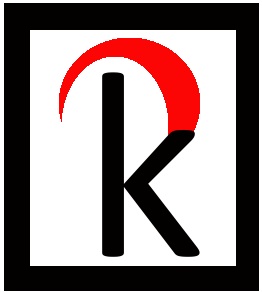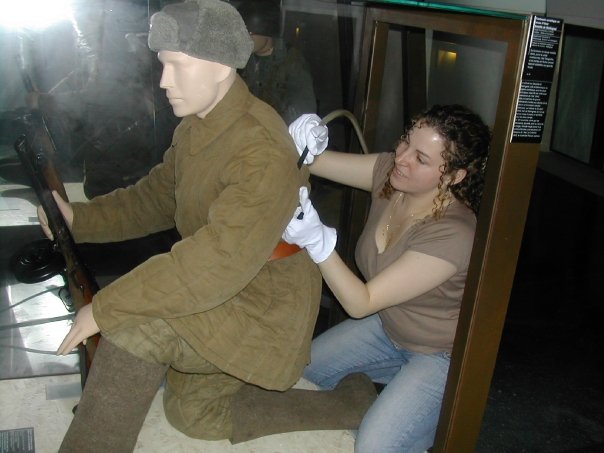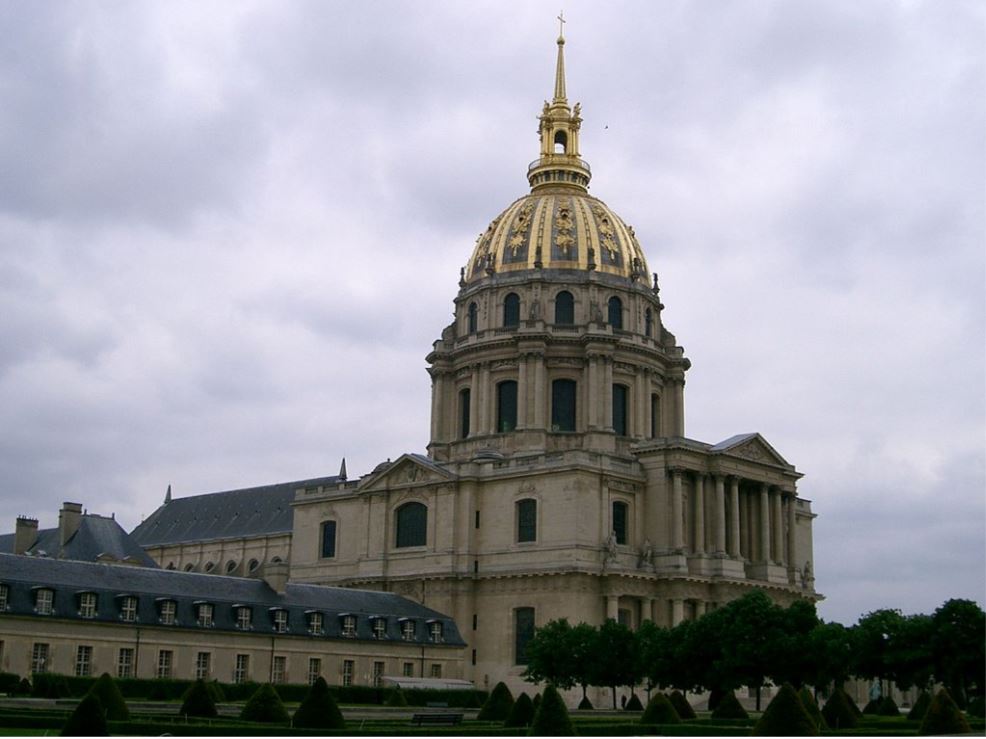Cataloguing Collections: Why, When, and How
Creating a complete record is an essential task in collections management, but for many collectors and institutions documenting each object in their possession may be arduous and sometimes seemingly costly. This is especially true when the collection is made up of several hundreds, if not thousands, of pieces.
At Renata Kaminker – Fine Art Solutions we believe that it is possible to create a full collections catalogue in a minimum of time and at a limited cost. Our job is to ensure that collections are properly cared for, and we do our best to adapt our offers to this end. We pride ourselves in making these operations simpler for our clients by either accompanying and guiding them every step of the way or taking care of the work to be done entirely.
Whether you are planning on hiring services such as ours or doing it on your own, there are a few things to keep in mind when creating a full inventory record.
Why Catalogue a Collection and When Should it Be Done
When to catalogue? As soon as the object enters the collection. If it has not been done at that time, then as soon as possible. When establishing your collection’s records the sooner it is done the better.
Why catalogue a collection? The simple answer is: because if you don’t know what you have, you won’t know what happened to it. A more complete answer requires delving into conservation and prevention issues, like theft and illicit trafficking.
Inventories allow for a detailed documentation of all objects as well as an accounting of their state of conservation at T-Time. A periodic survey, once a year, for example, allows for steady control of the works and immediate treatment if a change in state is noticed. This is essential in ensuring the long-term conservation of the pieces.
Regarding the issue of prevention, while one does not expect to either have an object stolen or find an illegally traded artefact in their hands, the fact is that theft and illicit trafficking are more common than one thinks. Those who do not have records of their objects can rarely recover them if they do disappear. An inventory file, complete with detailed photographs, is essential in recognizing and recovering works when they’re being resold after a theft.
In the case of an illicitly traded work, the inventory file serves as a record of when and how it entered the collection. And, if the documentation has been done thoroughly, will include all the paperwork regarding provenance and due diligence measures taken at the time of acquisition.
Furthermore, having a full understanding of what you have is a prerequisite when engaging in activities such as research or risk management. The former applies whether you wish to increase the value of a piece before a sale or are thinking of someday lending one for an exhibit. The latter refers back to collections preservation and protection: if you don’t know what you have and what state it is in, it will be impossible to put the proper preventive conservation, handling, and security measures in place.
Lastly, having a complete catalogue is also of great importance for insurance purposes. Comprehensive documentation can be very valuable when guaranteeing that your policy covers you properly as, over time, your collection grows in size and value. You should ideally be providing a complete record at the start of the policy, or at the latest at the time of renewal. Most insurers will usually also accept to do a policy review, if needed, when submitting or updating the records during the year.
How to Catalogue a Collection
Cataloguing can mean creating simple and quick record sheets for each piece or a more detailed file. We always advise our clients to have as much information as possible, and while this does mean more time and effort dedicated to the task when first establishing them, it also means that once the information is written down all that will be needed is a simple annual update.
Inventories, whether simple or detailed, always have the same basic categories of information. It is the level of details in these categories that make the difference.
An inventory record should have the following data:
A unique object number, using a standardised format for all the works in the collection.
The title of the piece, or if there is none then a brief one-line description.
Author, if known, otherwise Anonymous or Unknown can also be used.
If the pieces belong to a grouping or set (e.g., a jewellery or tea set), clearly indicate the number of objects in it.
A brief description, longer than the one replacing the title of the piece (2-3 lines will do).
The location of the piece, to be updated every time it is moved.
Pictures (front, back, and any important or unique details).
Technique and materials.
Date or era.
Dimensions, including the unit used.
A condition report.
Any new or updated file should also have the name of the person who worked on it and the date. This is essential in keeping track of any changes.
When delving deeper into the details, and as much as possible, records should be accompanied by:
All available documentation on the provenance of the piece.
Research references.
Handling, storage, and display requirements.
Lastly, keeping this rich documentation in a specialised database is highly recommended. While having Excel or Word files is quite common, and can serve as a temporary measure, the larger a collection is the more it needs specific technical measures put in place. The databases not only help keep track more easily of the piece’s information, such as updates to its location or the state of conservation, but most of them also feature tagging systems and broader categories that help locate similar or related objects within the collection. This is especially useful when trying to regroup objects for either a sale or a loan.
In Short
Catalogue your collection so that you know what you have, what state it is in, and how to best protect it.
Inventory records can be simple and quick, or more detailed. Both are acceptable but needless to say the more information you have the better.
Using a database is always preferable to Excel or Word files, especially for larger collections.
If you don’t know how to do any of this, are overwhelmed by the task, or don’t have the human resources to do it yourself, don’t be afraid to call on specialised services to handle it for you. These will not always be as costly as you may expect.
Providing better value to collectors: Technical analysis and collections management combined
The partnership between Art in Lab and Renata Kaminker – Fine Art Solutions, has allowed a collection’s owner to find the response to its scientific and collections management needs in one single place, thus saving valuable time and resources
Estelle Itié from Art in Lab and I are hard at work studying paintings under three different but complementary techniques:
Raking light
Ultraviolet (UV) photography
Infrared (IR) Reflectography
Each one of these analytical techniques provides a new level of information which will allow us to acquire a deeper understanding of the pieces under our care and the artist that produced them, while serving as added data to the inventory files being prepared.
In its most basic form, raking light renders the differences in the surface texture of the painting more visible, UV photography will provide information on which areas have been over-painted or if there is a varnish on the surface, and IR Microscopy will reveal any underlying drawings.
When combined with the previous study of the stratigraphic layers, performed a few weeks ago with co-founder of Art in Lab Ilenia Cassan, these images will allow to not only have empirical data supporting or refuting the artworks’ dating theories, but also allow for better future conservation treatment choices.
* Our client’s privacy being one of our prime concerns, when sharing any images we do so with the owner’s written permission and ensuring that the artworks are either blurred or have only details appear.
Raking light
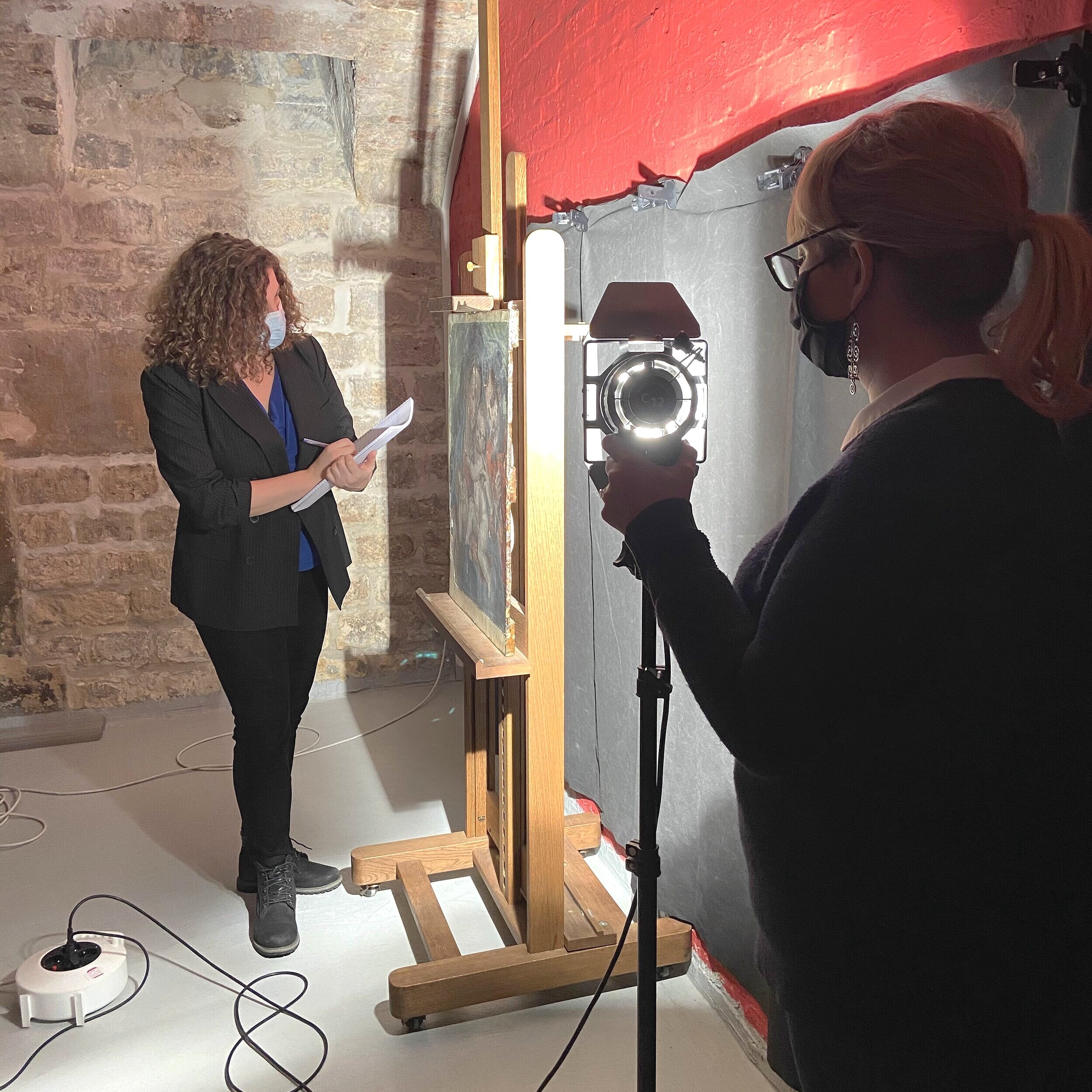
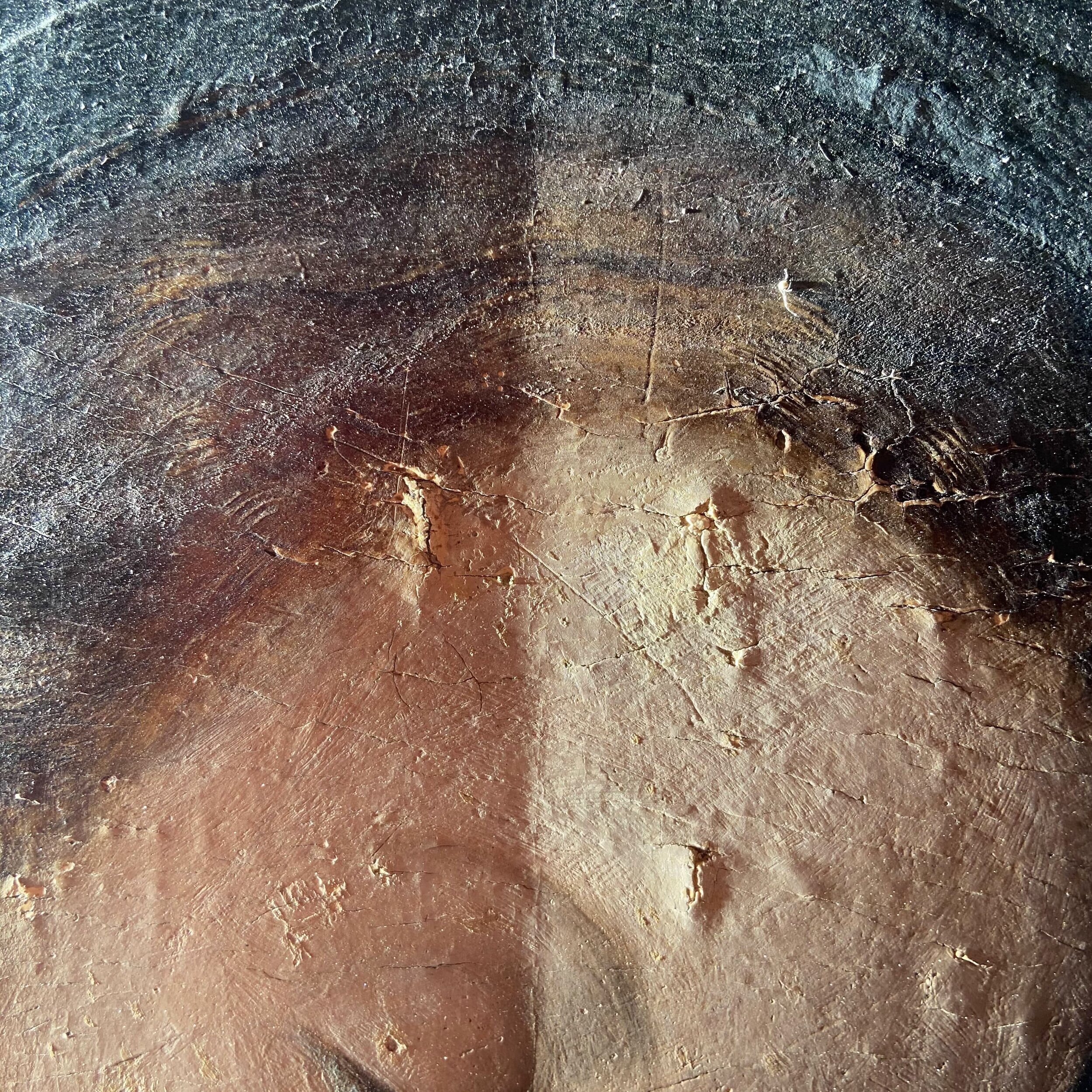

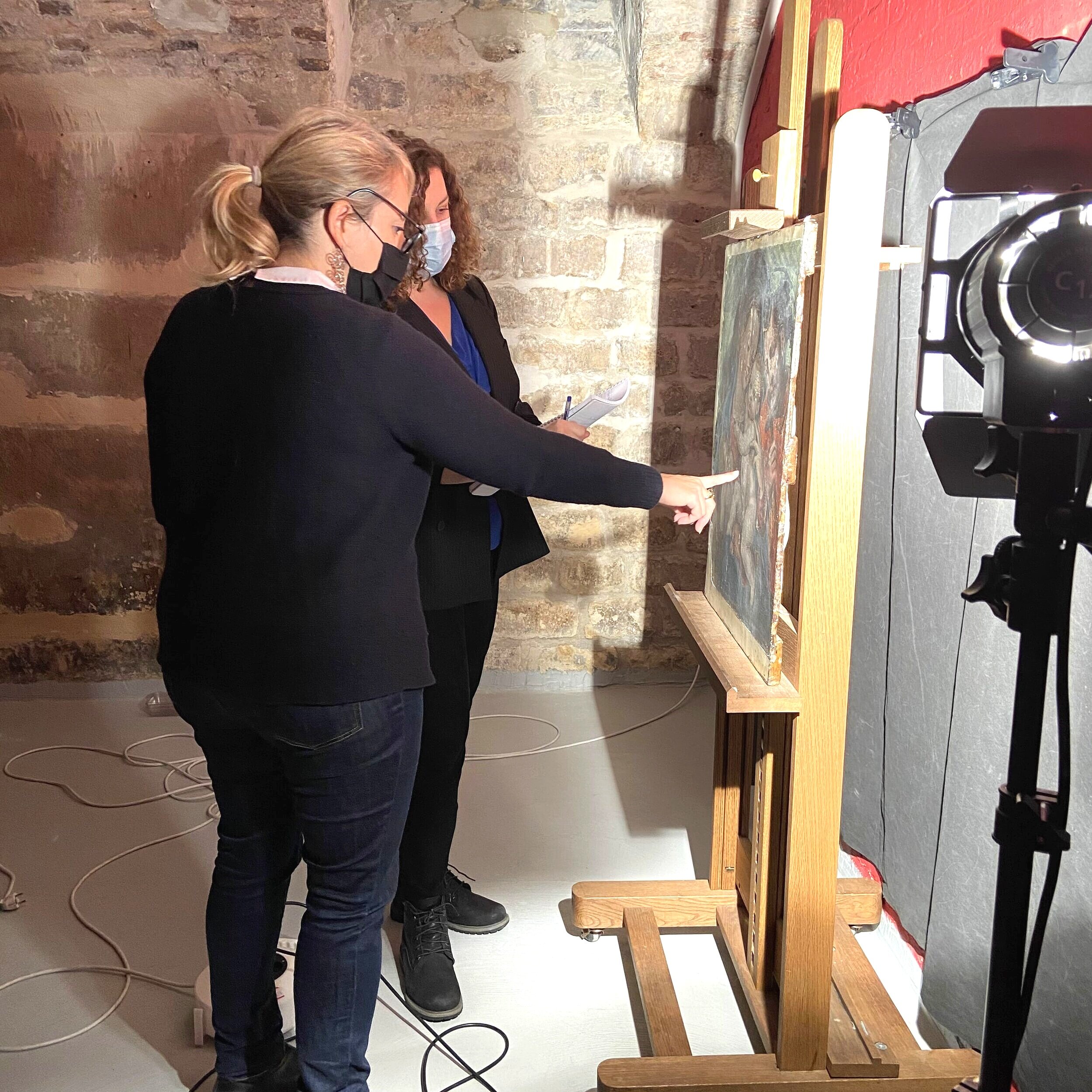
Under raking light, the painting is illuminated from only one side, at an oblique angle as related to its surface.
As stated above, raking light allows us to clearly see the surface’s texture, highlighting any differences, be it due to damage or to the artists’ doing, such as thicker brushstrokes or an impasto.
It is one of the two most common techniques used by conservators to study a piece when preparing a condition report as it reveals easily, quickly, and very clearly the surface condition of a painting.
Ultraviolet (UV) photography
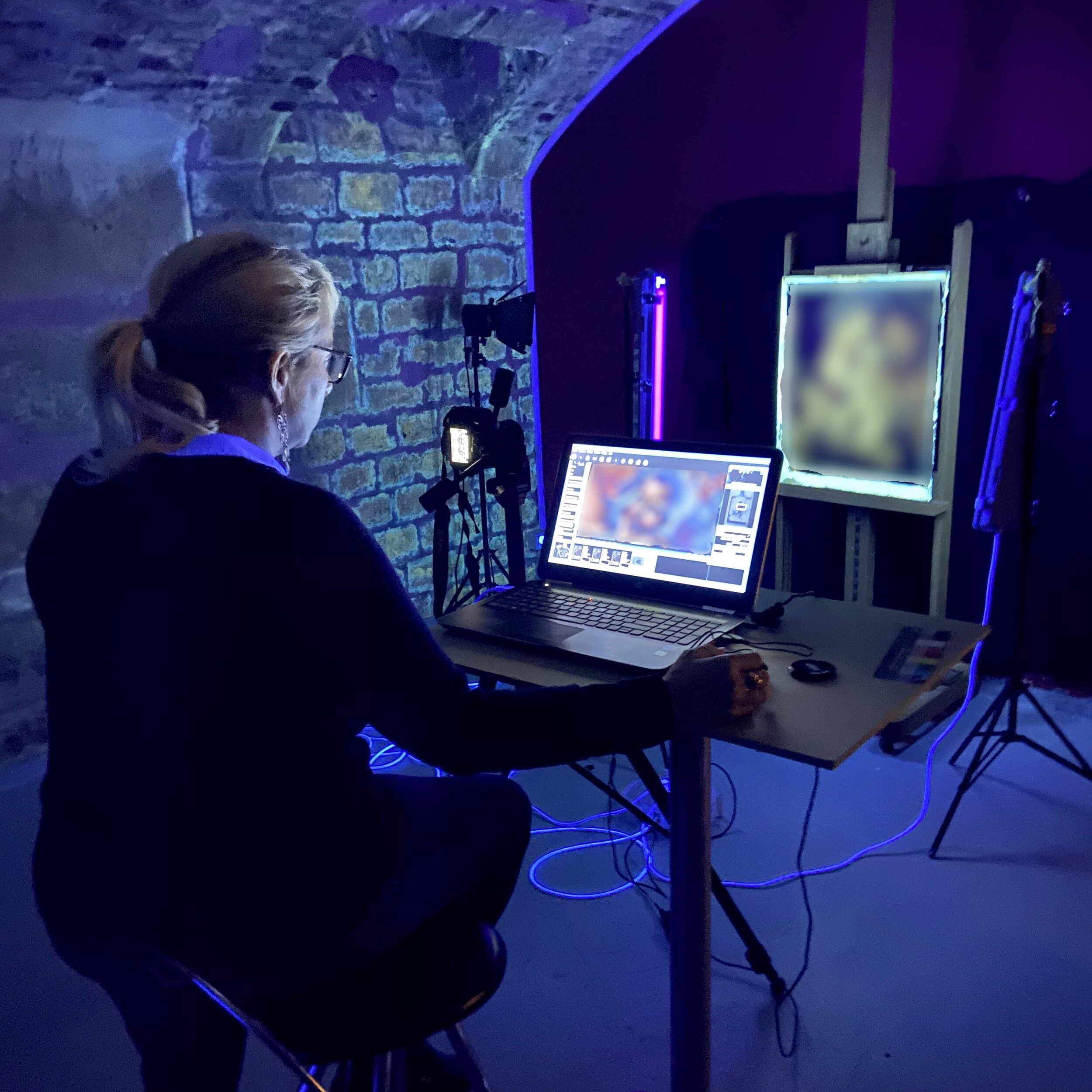
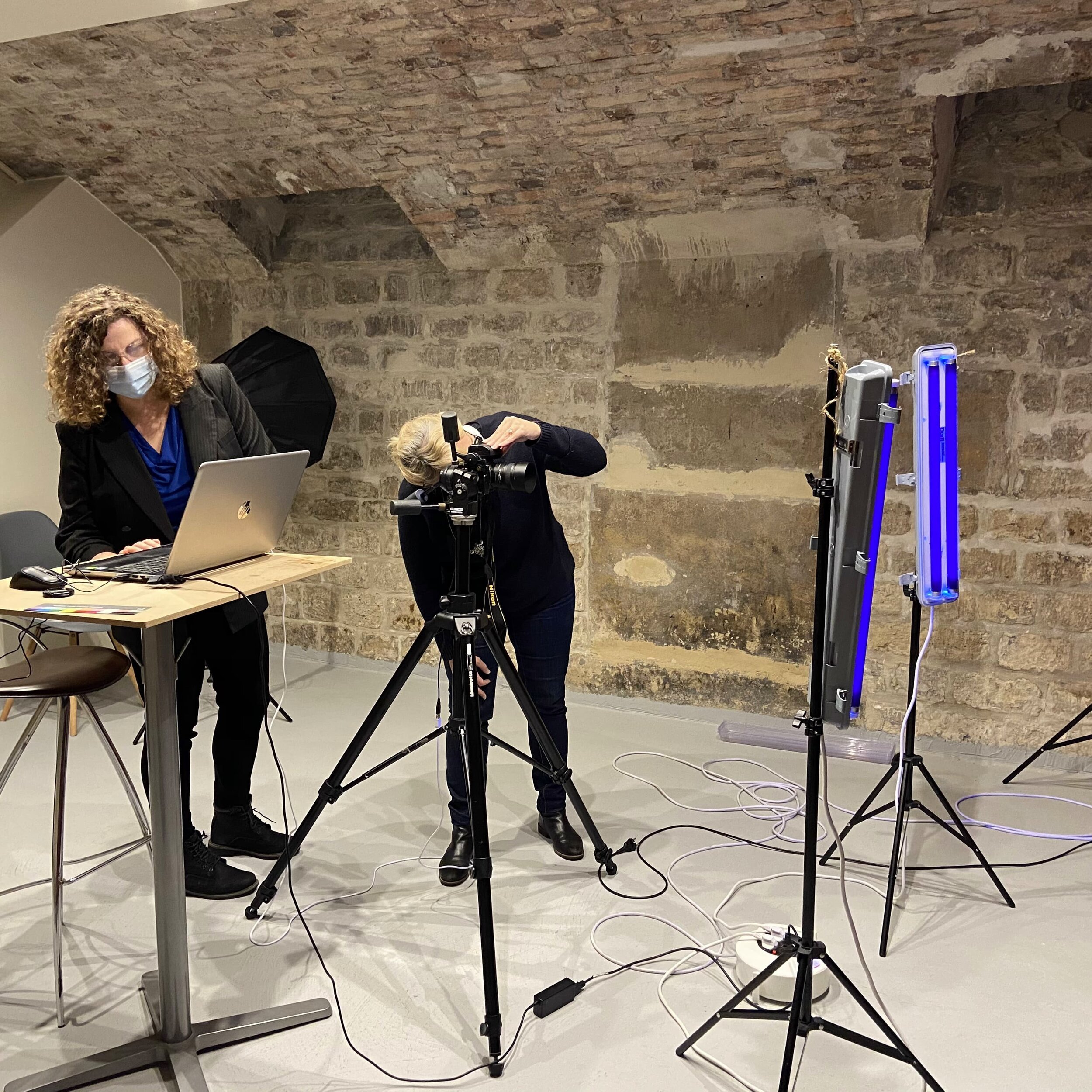
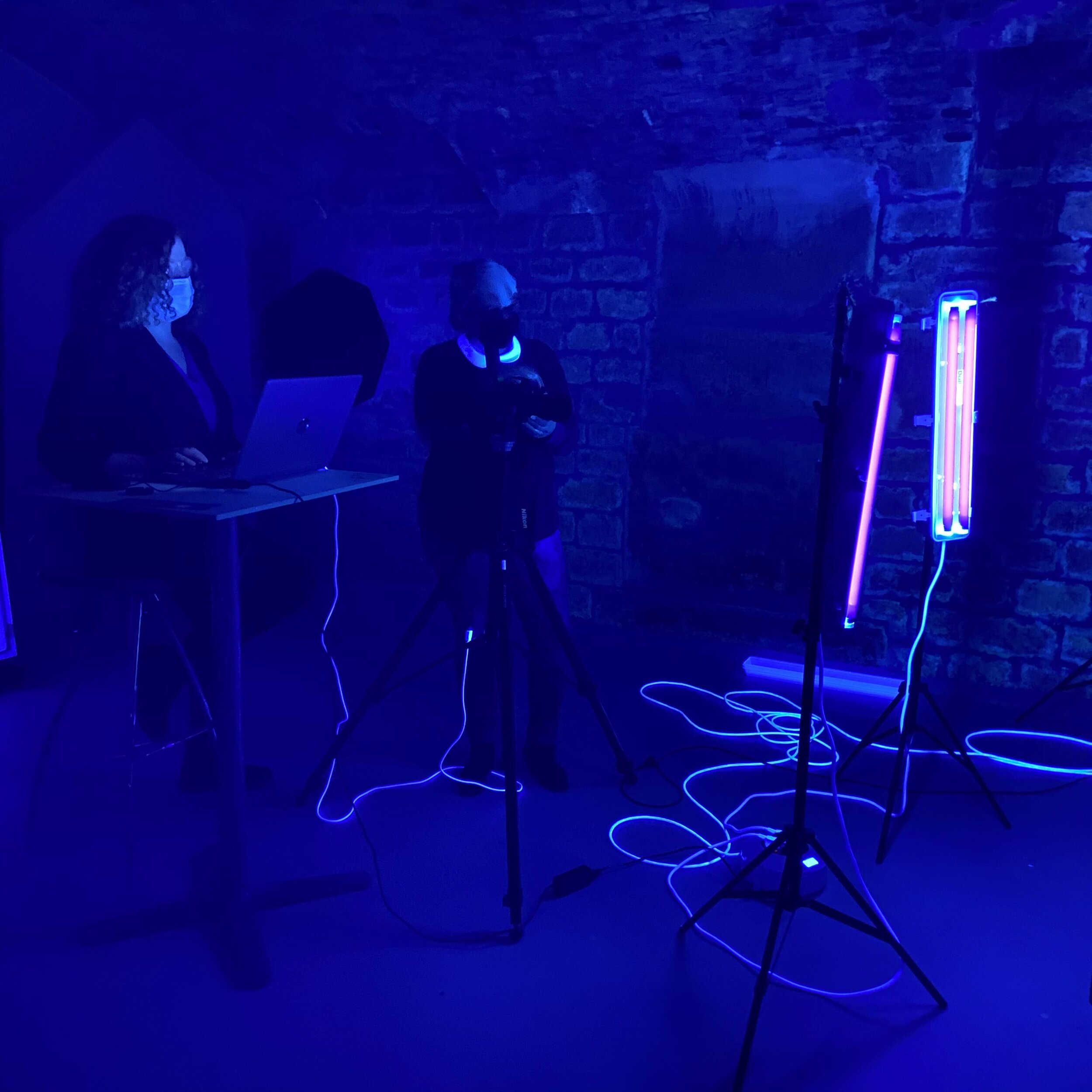
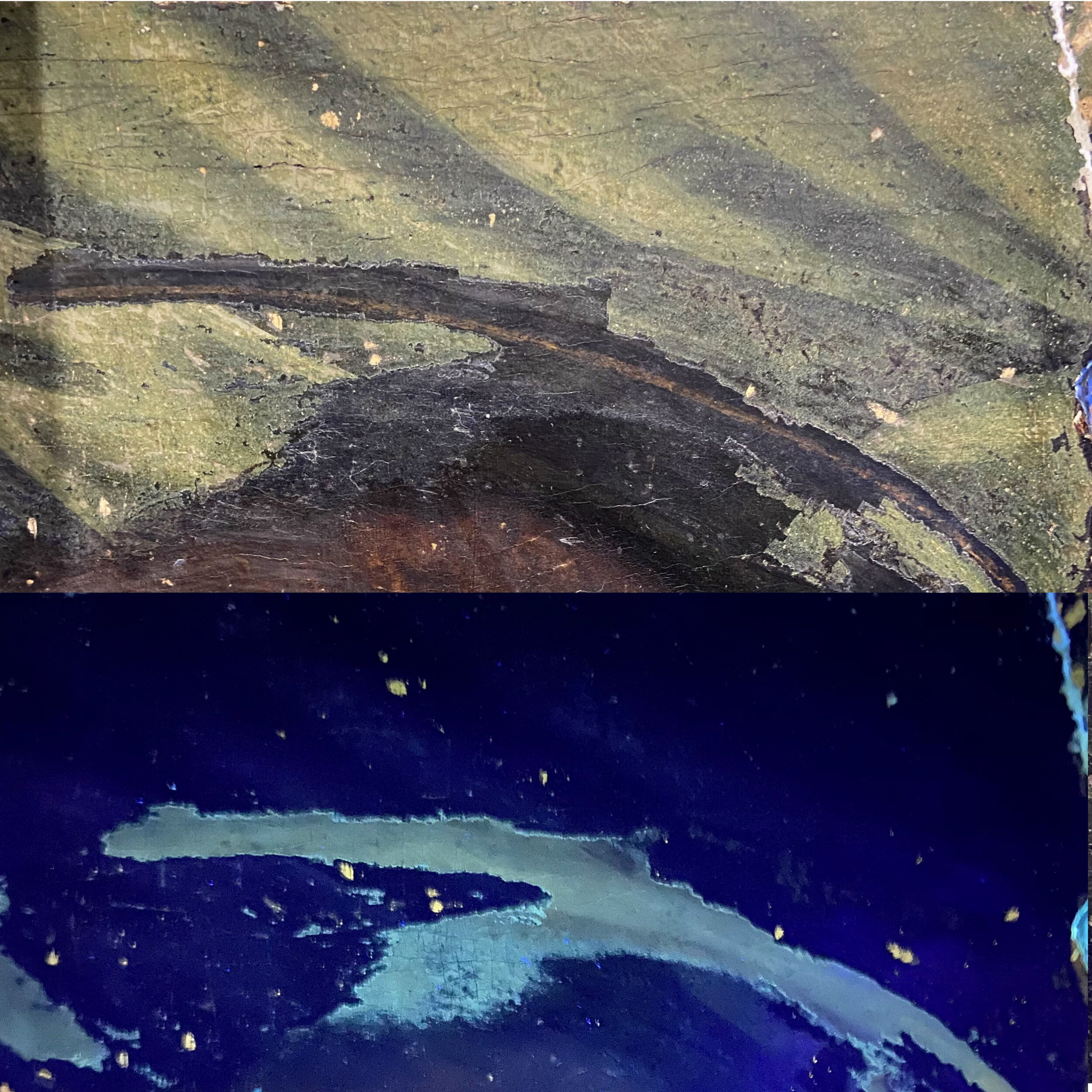
UV light is the other analytical technique most commonly used by conservators and conservation scientists alike, and is also included in condition reports.
UV light reveals:
Previous restorations, such as retouchings
Over-paintings
The presence of older natural resin varnishes
The probability of a signature or inscription’s authenticity, when compared to the surface surrounding it
The state of an artwork’s varnish
We have chosen to take things taken a step further and, in agreement with our client, have added these images to the collection’s inventory files for use in future treatment choices as well as comparison should there be any issues with the preventive conservation and storage measures that they decided on.
Infra-Red (IR) Reflectography
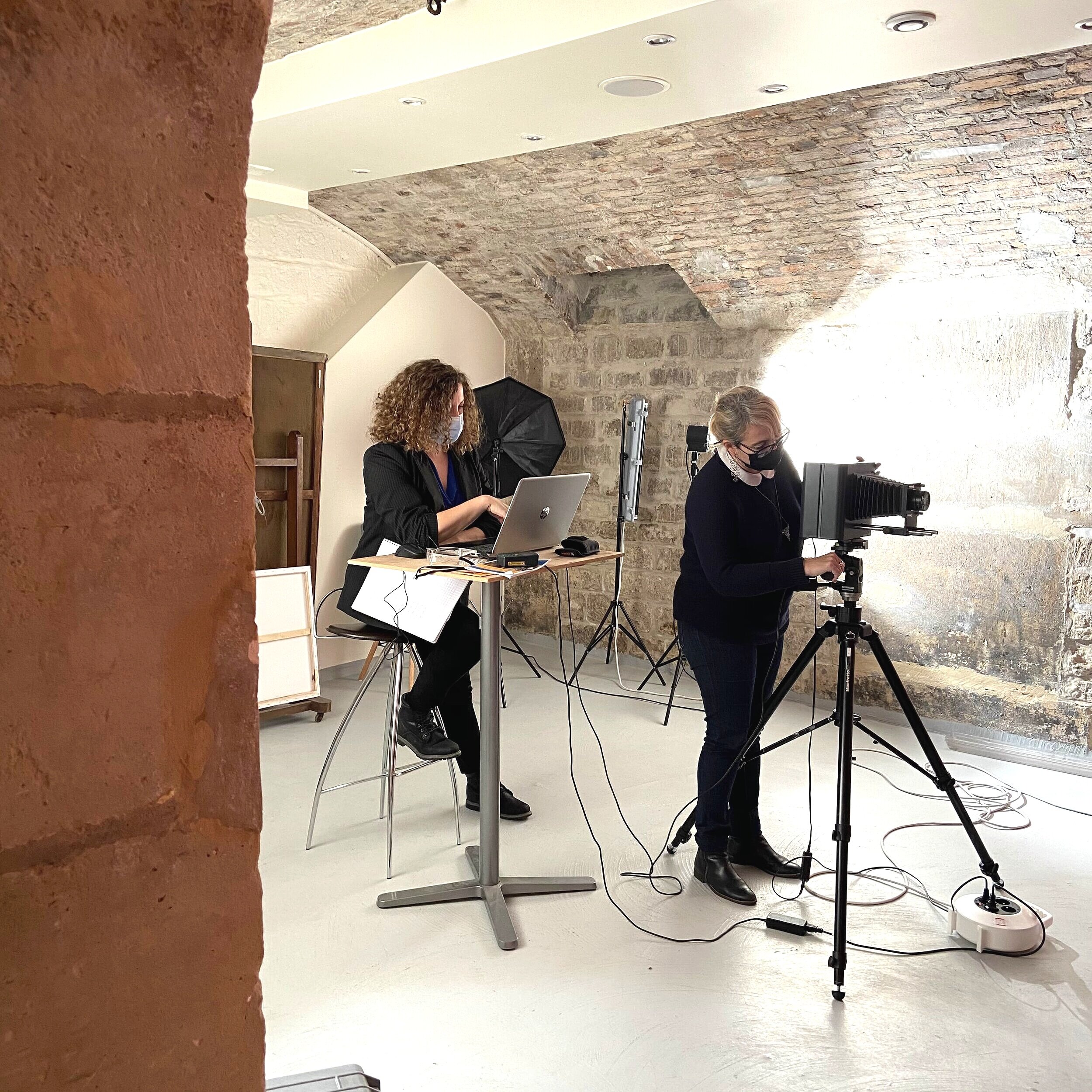
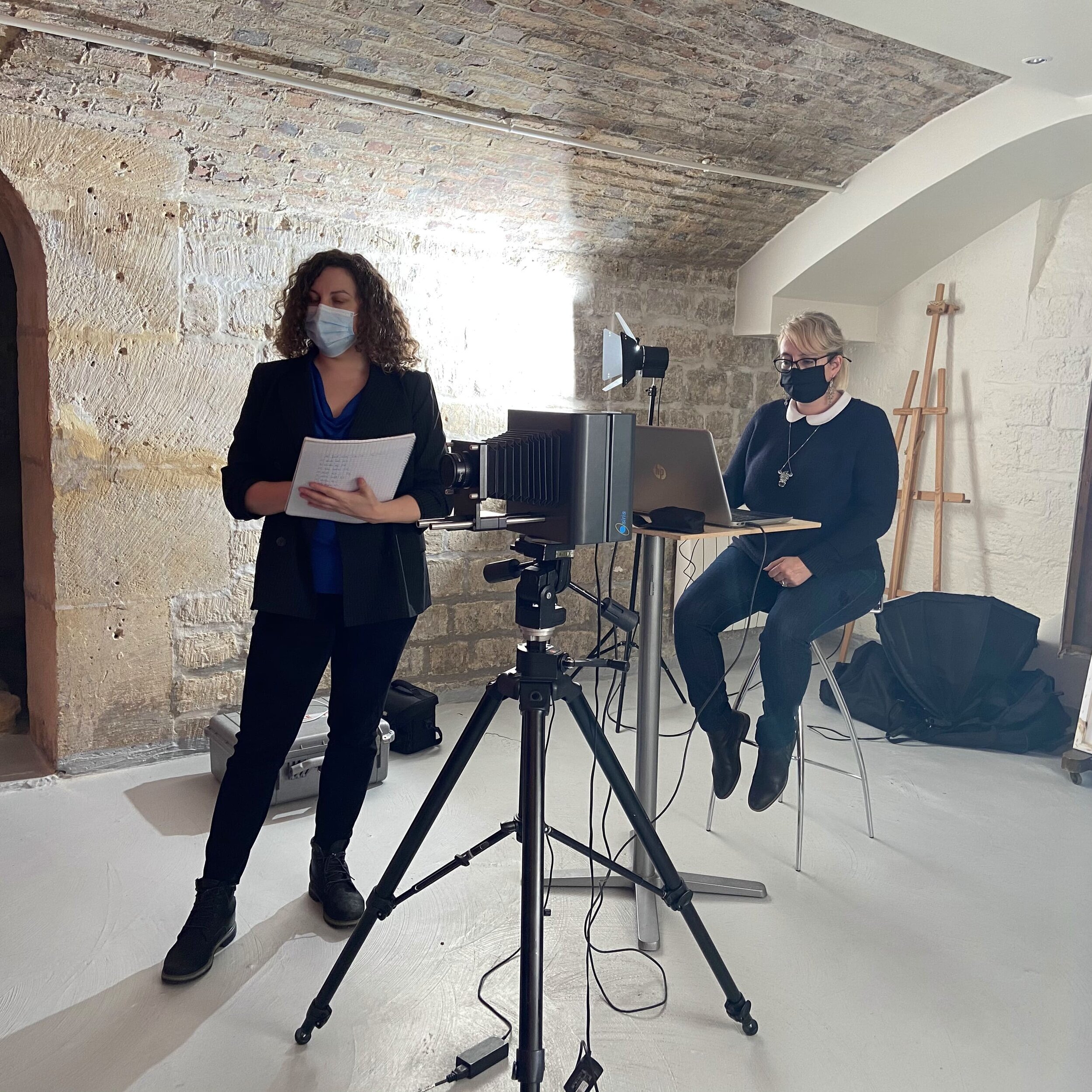
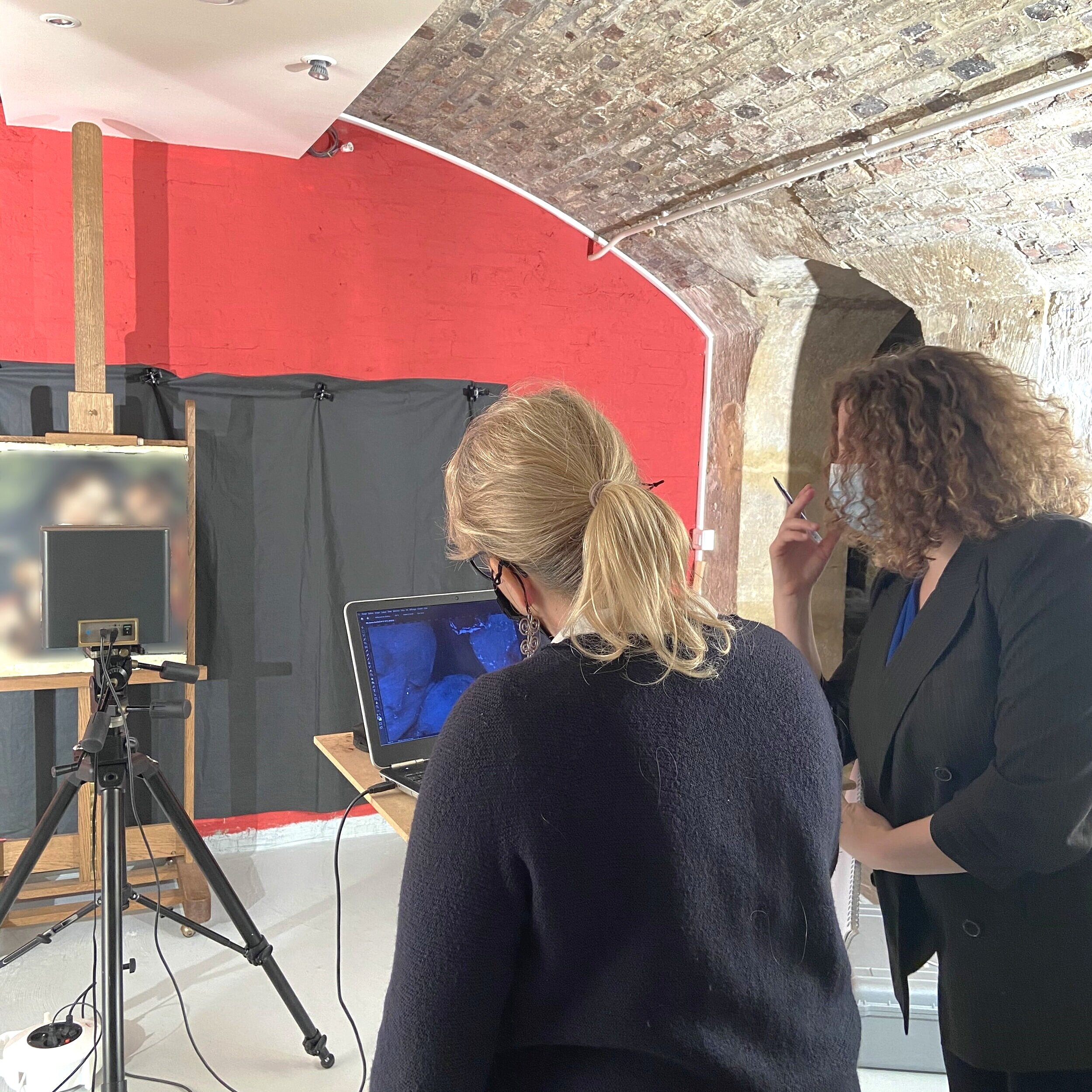
IR Reflectography is used to “see through” paint layers. This imaging technique allows us to study any existing underdrawings or compositional changes that lie beneath the visible paint layers.
IR Reflectography allows researchers to further understand the working process of an artist, which in turn will inform conservators on how to proceed. It is also used to help reveal fakes and forgeries, as these rarely have the type of underdrawings an original painting has, with all its mistakes and changes decided by the artist.
It’s been wonderful working on this collection with Art in Lab, and I look forward to future projects together. Throughout several weeks we have analysed paintings from different time periods and in different mediums, have created inventory files for all the pieces, and added condition reports to each one of these.
Thanks to the partnership between our two services the owner of these pieces has a full response to the questions of what he has, what state it is in, and what can be done to preserve it all moving forward, all in one place and without having to risk transporting the pieces or spending time going to see different specialists each in their own location.
"Managing Your Collection" article published in Art Law Club
I’m grateful to the Art Law Club for the invitation to write an article on collections management back in March 2020. It was a pleasure to touch on such important issues as preventive conservation and inventories.
“Managing a collection is both a simple and complex issue. There are a set number of guidelines that institutions should follow, and which cover a wide range of areas. This can seem overwhelming when one is faced with a whole collection and an entire building instead of individual pieces and rooms. It is because there is so much information to be considered that the prospect of managing a collection may seem daunting to some. In order to help institutions and their professionals get started with this task, this article aims to give a quick overview of the basic procedures…”
You may find the full article here: Managing Your Collection.
Renata Kaminker - Fine Art Solutions partners with Pinakotag for its work at the Musée Élise Rieuf!
Renata Kaminker - Fine Art Solutions is proud to present its new partnership with Pinakotag!
Video in French, with English subtitles
Pinakotag is a web-based management system that centralizes all relevant information (material, historical and administrative) for fine art collectors (private and institutional). It responds to the need for registering one’s collections and follow up each individual piece’s life (restoration, transportation, documentation, etc.). Under the guise of a traditional wax-seal is hidden a microchip linking to the relevant information. The chip is readable on any smartphone or tablet. Created by a painting’s conservator, it allies IoT technologies and fine art conservation constraints.
In partnership with Pinakotag, Renata Kaminker - Fine Art Solutions started on the final phase of setting a new inventorying process which would allow the Musée Élise Rieuf (Massiac, France) to confirm the localization of its artworks, update the inventory files, and fluidify and simplify their working process all in real time, rendering it all more time-efficient.
The system will allow the 3-person museum staff to quickly and efficiently organise the inventory of its collections, and follow-up on the localisation of its 600+ pieces at a rate of 150 artworks per hour and per person.
Renata Kaminker - Fine Art Solutions is delighted to have included in this new project! We aim to simplify the tasks of those who handle collections, large and small, freeing them so that their time may be used in pursuing other urgent matters.
What Our Clients Say About Us
“Pinakotag is very happy to work in partnership with R.K. Fine Art Solutions, as we have the same philosophy when it comes to artworks (love of art, respect for the material and history of the pieces, professional ethics) and a complementary approach to collection management.”
Renata Kaminker - Fine Art Solutions was invited by Sotheby's Institute of Art to talk at its Art Crime seminar
On July 8, 2019, and for the third year in a row, Renata Kaminker was invited to speak at Sotheby's Institute of Art’s Art Crime Seminar. We were delighted to have been included in this year’s programme, alongside such prestigious names as Vernon Rapley (Director of Cultural Heritage Protection and Security at the V&A), Peter Stone OBE (Professor at Newcastle University and UNESCO Chair in Cultural Property Protection and Peace), Noah Charney (Founder of ARCA), and Marc Masurovsky (Co-Founder of the Holocaust Art Restitution Project in Washington DC).
Over the course of half a day, Renata presented an overview on art crime, from the typologies of art crimes (theft and looting, heritage destruction, fakes and forgeries, artnapping…) to the main international legal framework, as well as the central players and tools in the fight against illicit trafficking. She also introduced students to what type of information should be included in due diligence procedures, the types of technical analyses that can be performed and the different types of inventories being used.
The presentation served as a general introduction to the biggest aspects of fighting art crime and helped students understand the who, what and how of this field. It was a true pleasure and honour to have been part of training a new generation of conscientious art market professionals.
Renata Kaminker - Fine Art Solutions works on national military collections
I had the honour several years ago of working for the French national museum, Musée de l’Armée – Hôtel national des Invalides (Paris). I was asked to apply remedial conservation measures, as well as create or update inventory files, for the museum’s 19th and 20th century military uniforms and other paraphernalia (textile, leather and metal).
It was a pleasure to work on a national collection such as this one, and to have been part for nearly a year of the museum’s 7-year building and exhibition spaces renovation project.
Renata Kaminker - Fine Art Solutions returns to MuséAl to train museum staff
Following the collections’ survey that Renata Kaminker - Fine Art Solutions performed performed for MuséAl (Ardèche, France), the archaeological and site museum in Alba-la-Romaine, in December 2018, I was delighted to have been back to MuséAl on 24-26 June to train the staff on:
How to manage their national collections according to the particularities of French museum legislation they fall under
How to properly handle museum objects
What is preventive conservation and how to apply it to their collections (in both the exhibition rooms and storage areas)
How to organize their storage rooms
Which were the legal and practical specificities regarding inventories that they needed to be aware of
How to prepare an emergency plan for the collections and the staff
The 2018 conservation survey was completed by a report which included a review of the state of conservation of the museum’s collections as well as of the state of their inventory and preventive conservation measures. The report included a suggestion on the order of work priorities, as well as information on the preventive conservation measures that the museum could take to better preserve their collections.
The report was then used by the museum to enhance their work and better prepare the budget and staff requirements for the following year.
I look forward to my next visit to MuséAl, to follow-up on the updating of their collection’s inventory!
